Controlled Synthesis of Europium-Doped SnS Quantum Dots for Ultra-Fast Degradation of Selective Industrial Dyes
Abstract
:1. Introduction
2. Results and Discussion
2.1. Structural Analysis
2.2. Morphological Analysis
2.3. Functional Group Analysis
2.4. Optical Analysis
2.5. Photocatalytic Studies of SnS and Eu Doped SnS QDs
2.6. Reactive Active Species
2.7. Photocatalysis Mechanism
| S. No. | Catalysts | Dye | Dye Conc. | Dose/Volume | Source | Time | Efficiency/% | Reference |
| 1. | SnS/LDPE | MB | 20 ppm | 100 mg/100 mL | Sun light | 180 min | 96.60 | [45] |
| 2. | CdS NPs | MB | 10 ppm | 5 mg/ 100 mL | Sun light | 120 min | 87.12 | [46] |
| 3. | ZnS-Ag | MB | 15 ppm | 100 mg/100 mL | Visible light | 120 min | ~100.00 | [47] |
| 4. | ZnS | MB | 10 ppm | 30 mg/100 mL | Sun light | 180 min | 72.13 | [48] |
| 5. | Ni-ZnS | MB | 10 ppm | 30 mg/100 mL | Sun light | 180 min | 87.38 | [48] |
| 6. | ZnS | MB | 20 ppm | 100 mg/100 mL | Sun light | 180 min | 49.00 | [49] |
| 7. | Sn-ZnS | MB | 20 ppm | 100 mg/100 mL | Sun light | 180 min | 93.00 | [49] |
| 8. | PbS | MB | 1 × 10−5 mol/L−1 (~16 ppm) | 50 mg/50 mL | UV light | 180 min | 25.00 | [50] |
| 9. | Ag-PbS | MB | 1 × 10−5 mol/L−1 (~16 ppm) | 50 mg/50 mL | UV light | 180 min | 68.00 | [51] |
| 10. | Bi2S3 | MB | - | - | Visible light | 140 min | 87.98 | [51] |
| 11. | CuS | MB | 5 ppm | 80 mg/50 mL | Visible light | 120 min | ~100.00 | [52] |
| 12. | CuS | CV | 5 ppm | 80 mg/50 mL | Visible light | 120 min | 84.60 | [52] |
| 13. | CdS | MB | 20 ppm | 25 mg/25 mL | Sun light | 180 min | 91.39 | [53] |
| 14. | Sn/CdS | MB | 20 ppm | 25 mg/ 25 mL | Sun light | 180 min | 97.56 | [53] |
| 15. | Eu-SnS | MB | 20 ppm | 25 mg/ 50 mL | Sun light | 180 min | 100.00 | Present study |
| 16. | Eu-SnS | CV | 20 ppm | 25 mg/ 50 mL | Sun light | 180 min | 97.00 | Present study |
2.8. Effect of pH
3. Experimental
3.1. Synthesis of Pure SnS and Eu-Doped SnS Quantum Dots (QDs)
3.2. Photocatalytic Dye Degradation
3.3. Characterization
4. Conclusions
Author Contributions
Funding
Data Availability Statement
Acknowledgments
Conflicts of Interest
References
- Elango, G.; Roopan, S.M. Efficacy of SnO2 nanoparticles towards photocatalytic degradation of methylene blue dye. J. Photochem. Photobiol. B Biol. 2016, 155, 34–38. [Google Scholar] [CrossRef] [PubMed]
- Shabani, M.; Haghighi, M.; Kahforoushan, V.; Haghighi, A. Mesoporous-mixed-phase of hierarchical bismuth oxychlorides nanophotocatalyst with enha nced photocatalytic application in treatment of antibiotic effluents. J. Clean. Prod. 2019, 207, 444–457. [Google Scholar] [CrossRef]
- Amini, M.; Ashrafi, M. Photocatalytic degradation of some organic dyes under solar light irradiation using TiO2 and ZnO nanoparticles. Nano. Chem. Res. 2016, 1, 79–86. [Google Scholar]
- Mohamed, H.H. Rationally designed Fe2O3/GO/WO3 Z-Scheme photocatalyst for enhanced solar light photocatalytic water remediation. J. Photochem. Photobiol. A Chem. 2019, 378, 74–84. [Google Scholar] [CrossRef]
- Pavithra, K.G.; Kumar, P.S.; Jaikumar, V.; Rajan, P.S. Removal of colorants from wastewater: A review on sources and treatment strategies. J. Ind. Eng. Chem. 2019, 75, 1–19. [Google Scholar] [CrossRef]
- Lai, X.; Guo, R.; Xiao, H.; Lan, J.; Jiang, S.; Cui, C.; Ren, E. Rapid microwave-assisted bio-synthesized silver/Dandelion catalyst with superior catalytic performance for dyes degradation. J. Hazard. Mater. 2019, 371, 506–512. [Google Scholar] [CrossRef]
- Hussain, W.; Badshah, A.; Imtiaz-ud-Din, R.A.H.; Aleem, M.A.; Bahadur, A.; Iqbal, S.; Farooq, M.U.; Ali, H. Photocatalytic applications of Cr2S3 synthesized from single and multi-source precursors. Mater. Chem. Phys. 2017, 194, 345–355. [Google Scholar] [CrossRef]
- Hussain, W.; Malik, H.; Bahadur, A.; Hussain, R.A.; Shoaib, M.; Iqbal, S.; Hussain, H.; Green, I.R.; Badshah, A.; Li, H. Synthesis and characterization of CdS photocatalyst with different morphologies: Visible light activated dyes degradation study. Kinet. Catal. 2018, 59, 710–719. [Google Scholar] [CrossRef]
- Anwer, H.; Mahmood, A.; Lee, J.; Kim, K.; Park, J.; Yip, A.C.K. Photocatalysts for degradation of dyes in industrial effluents: Opportunities and challenges. Nano Res. 2019, 12, 955–972. [Google Scholar] [CrossRef]
- Das, T.K.; Ganguly, S.; Bhawal, P.; Remanan, S.; Mondal, S.; Das, N.C. Mussel inspired green synthesis of silver nanoparticles-decorated halloysite nanotube using dopamine: Characterization and evaluation of its catalytic activity. Appl. Nanosci. 2018, 8, 173–186. [Google Scholar] [CrossRef]
- Das, T.K.; Remanan, S.; Ghosh, S.; Ghosh, S.K.; Das, N.C. Efficient synthesis of catalytic active silver nanoparticles illuminated cerium oxide nanotube: A mussel inspired approach. Environmental Nanotechnology. Monit. Manag. 2021, 15, 100411. [Google Scholar] [CrossRef]
- Hitam, C.N.C.; Jalil, A.A. A review on exploration of Fe2O3 photocatalyst towards degradation of dyes and organic contaminants. J. Environ. Manag. 2020, 258, 110050. [Google Scholar] [CrossRef] [PubMed]
- Preet, K.; Gupta, G.; Kotal, M.; Kansal, S.K.; Salunke, D.B. Mechanochemical Synthesis of a New Triptycene-Based Imine-Linked Covalent Organic Polymer for Degradation of Organic Dye. Cryst. Growth Des. 2019, 19, 2525–2530. [Google Scholar] [CrossRef]
- Phil, S.; Yong, M.; Chul, H. Photocatalytic activity of SnO2 nanoparticles in methylene blue degradation. Mater. Res. Bull. 2016, 74, 85–89. [Google Scholar]
- Jia, X.; Liu, Y.; Wu, X.; Zhang, Z. A low temperature situ precipitation route to designing Zn-doped SnO2 photocatalyst with enhanced photocatalytic performance. Appl. Surf. Sci. 2014, 311, 609–613. [Google Scholar] [CrossRef]
- Mahmoodi, N.M.; Abdi, J.; Oveisi, M.; Asli, M.A.; Vossoughi, M. Metal-organic framework (MIL-100 (Fe)): Synthesis, detailed photocatalytic dye degradation ability in colored textile wastewater and recycling. Mater. Res. Bull. 2017, 100, 357–366. [Google Scholar] [CrossRef]
- Ninan, G.G.; Sudha Kartha, C.; Vijayakumar, K.P. On the preparation of n-type SnS:Cu using chemical spray pyrolysis for photovoltaic application: Effect of annealing. Sol. Energy Mater. Sol. Cells 2016, 157, 229–233. [Google Scholar] [CrossRef]
- Jamali-Sheini, F.; Yousefi, R.; Ali Bakr, N.; Cheraghizade, M.; Sookhakian, M.; Huang, N.M. Highly efficient photo-degradation of methyl blue and band gap shift of SnS nanoparticles under different sonication frequencies. Mater. Sci. Semicond. Process. 2015, 32, 172–178. [Google Scholar] [CrossRef]
- Tang, R.; Su, H.; Sun, Y.; Zhang, X.; Li, L.; Liu, C.; Zeng, S.; Sun, D. Enhanced photocatalytic performance in Bi2WO6/SnS heterostructures: Facile synthesis, influencing factors and mechanism of the photocatalytic process. J. Colloid Interface Sci. 2016, 466, 388–399. [Google Scholar] [CrossRef]
- Suryawanshi, S.R.; Warule, S.S.; Patil, S.S.; Patil, K.R.; More, M.A. Vapor-liquid-solid growth of one-dimensional tin sulfide (SnS) nanostructures with promising field emission behavior. ACS Appl. Mater. Interfaces 2014, 6, 2018–2025. [Google Scholar] [CrossRef]
- Vaughn, D.D.; Hentz, O.D.; Chen, S.; Wang, D.; Schaak, R.E. Formation of SnS nanoflowers for lithium-ion batteries. Chem. Commun. 2012, 48, 5608–5610. [Google Scholar] [CrossRef] [PubMed]
- Lu, F.; Yang, J.; Li, R.; Huo, N.; Li, Y.; Wei, Z.; Li, J. Gas-dependent photoresponse of SnS nanoparticles-based photodetectors. J. Mater. Chem. C 2015, 3, 1397–1402. [Google Scholar] [CrossRef]
- Zhou, X.; Gan, L.; Zhang, Q.; Xiong, X.; Li, H.; Zhong, Z.; Han, J.; Zhai, T. High performance near-infrared photodetectors based on ultrathin SnS nanobelts grown via physical vapor deposition. J. Mater. Chem. C 2016, 4, 2111–2116. [Google Scholar] [CrossRef]
- Wang, J.; Lian, G.; Xu, Z.; Fu, C.; Lin, Z.; Li, L.; Wang, Q.; Cui, D.; Wong, C.P. Growth of Large-Size SnS Thin Crystals Driven by Oriented Attachment and Applications to Gas Sensors and Photodetectors. ACS Appl. Mater. Interfaces 2016, 8, 9545–9551. [Google Scholar] [CrossRef] [PubMed]
- Jamali-sheini, F.; Cheraghizade, M.; Yousefi, R. Ultrasonic synthesis of In-doped SnS nanoparticles and their physical properties. Solid State Sci. 2018, 79, 30–37. [Google Scholar] [CrossRef]
- Cheraghizade, M.; Jamali-sheini, F.; Yousefi, R.; Niknia, F.; Mahmoudian, M.R.; Sokhakian, M. The effect of tin sulfide quantum dots size on photocatalytic and photovoltaic performance. Mater. Chem. Phys. 2017, 195, 187–194. [Google Scholar] [CrossRef]
- Firtina Ertis, I.; Boz, I. Synthesis and Characterization of Metal-Doped (Ni, Co, Ce, Sb) CdS Catalysts and Their Use in Methylene Blue Degradation under Visible Light Irradiation. Mod. Res. Catal. 2017, 6, 1–14. [Google Scholar] [CrossRef]
- Khataee, A.R.; Karimi, A.; Soltani, R.D.C.; Safarpour, M.; Hanifehpour, Y.; Joo, S.W. Europium-doped ZnO as a visible light responsive nanocatalyst: Sonochemical synthesis, characterization and response surface modeling of photocatalytic process. Appl. Catal. A Gen. 2014, 488, 160–170. [Google Scholar] [CrossRef]
- Kumar, A.; Babu, S.; Karakoti, A.S.; Schulte, A.; Seal, S. Luminescence properties of europium-doped cerium oxide nanoparticles: Role of vacancy and oxidation states. Langmuir 2009, 25, 10998–11007. [Google Scholar] [CrossRef]
- Sin, J.C.; Lam, S.M.; Satoshi, I.; Lee, K.T.; Mohamed, A.R. Sunlight photocatalytic activity enhancement and mechanism of novel europium-doped ZnO hierarchical micro/nanospheres for degradation of phenol. Appl. Catal. B Environ. 2014, 148–149, 258–268. [Google Scholar] [CrossRef]
- Phuruangrat, A.; Yayapao, O.; Thongtem, T.; Thongtem, S. Synthesis and characterization of europium-doped zinc oxide photocatalyst. J. Nanomater. 2014, 2014, 367529. [Google Scholar] [CrossRef]
- Khatamian, M.; Khandar, A.A.; Divband, B.; Haghighi, M.; Ebrahimiasl, S. Heterogeneous photocatalytic degradation of 4-nitrophenol in aqueous suspension by Ln (La3+, Nd3+ or Sm3+) doped ZnO nanoparticles. J. Mol. Catal. A Chem. 2012, 365, 120–127. [Google Scholar] [CrossRef]
- Sukriti, P.; Chand, V. Singh, Enhanced visible-light photocatalytic activity of samarium-doped zinc oxide nanostructures. J. Rare Earths. 2020, 38, 29–38. [Google Scholar] [CrossRef]
- Ranjith Kumar, D.; Ranjith, K.S.; Rajendra Kumar, R.T. Structural, optical, photocurrent and solar driven photocatalytic properties of vertically aligned samarium doped ZnO nanorod arrays. Optik 2018, 154, 115–125. [Google Scholar] [CrossRef]
- Greyson, E.C.; Jeremy, E.B.; Teri, W.O. Tetrahedral zinc blende tin sulfide nano- and microcrystals. Small 2016, 2, 368–371. [Google Scholar]
- Johnson, J.B.; Jones, H.; Latham, B.S.; Parker, J.D.; Engelken, R.D.; Barber, C. Optimization of photoconductivity in vacuum-evaporated tin sulfide thin films. Semicond. Sci. Technol. 1999, 14, 501–507. [Google Scholar] [CrossRef]
- Chamberlain, J.M.; Merdan, M. Infrared photoconductivity in p-SnS. J. Phys. C Solid State Phys. 1977, 10, L571–L574. [Google Scholar] [CrossRef]
- Rana, C.; Ranjan, S.; Satyajit, B. Growth of SnS nanoparticles and its ability as ethanol gas sensor. J. Mater. Sci. Mater. Electron. 2019, 30, 2016–2029. [Google Scholar] [CrossRef]
- Sun, H.; Liu, S.; Liu, S.; Wang, S. A comparative study of reduced graphene oxide modified TiO2, ZnO and Ta2O5 in visible light photocatalytic/photochemical oxidation of methylene blue. Appl. Catal. B Environ. 2014, 146, 162–168. [Google Scholar] [CrossRef]
- Xin, L.; Miroslava, E.; Pengwei, H.; Kamila, K. Fabrication of highly stable CdS/g-C3N4 composite for enhanced photocatalytic degradation of RhB and reduction of CO2. J. Mater. Sci. 2020, 55, 3299–3313. [Google Scholar]
- Saravanan, R.; Karthikeyan, S.; Gupta, V.K.; Sekaran, G.; Narayanan, V.; Stephen, A. Enhanced photocatalytic activity of ZnO/CuO nanocomposite for the degradation of textile dye on visible light illumination. Mater. Sci. Eng. C 2013, 33, 91–98. [Google Scholar] [CrossRef]
- Kashinath, V.G.L.; Daniel, D.J. Sol-gel mediated microwave synthesis of pure, La and Zr doped SnS2 nanoflowers an efficient photocatalyst for the degradation of ethylene blue. J. Mater. Sci. Mater. Electron. 2019, 30, 7963–7973. [Google Scholar]
- Ranjith Kumar, D.; Ranjith, K.S.; Nivedita, L.R.; Asokan, K.; Rajendra Kumar, R.T. Swift heavy ion induced effects on structural, optical and photo-catalytic properties of Ag irradiated vertically aligned ZnO nanorod arrays. Nucl. Instrum. Methods Phys. Res. Sect. B Beam Interact. Mater. Atoms. 2019, 450, 95–99. [Google Scholar] [CrossRef]
- Song, S.; Wu, K.; Wu, H.; Guo, J.; Zhang, L. Effect of Fe/Sn doping on the photocatalytic performance of multi-shelled ZnO microspheres: Experimental and theoretical investigations. Dalton Trans. 2019, 48, 13260–13272. [Google Scholar] [CrossRef]
- Hegde, S.S.; Surendra, B.S.; Priyanka, V.P.; Murahari, P.; Ramesh, K. SnS/LDPE Composite: A reusable floating photocatalyst for solar degradation of organic dyes. Mater. Today Proc. 2021, 47, 4255–4261. [Google Scholar] [CrossRef]
- Ullah, A.; Rasheed, S.; Ali, I.; Ullah, N. Plant mediated synthesis of CdS nanoparticles: Their characterization and application for photocatalytic degradation of toxic organic dye. Chem Rev. Lett. 2021, 4, 98–107. [Google Scholar]
- Sivakumar, P.; Gaurav Kumar, G.K.; Sivakumar, P.; Renganathan, S. Synthesis and characterization of ZnS-Ag nanoballs and its application in photocatalytic dye degradation under visible light. J. Nanostruct. Chem. 2014, 4, 107. [Google Scholar] [CrossRef]
- Jothibas, M.; Manoharan, C.; Johnson Jeyakumar, S.; Praveen, P.; Kartharinal Punithavathy, I.; Prince Richard, J. Synthesis and enhanced photocatalytic property of Ni doped ZnS nanoparticles. Sol. Energy. 2018, 159, 434–443. [Google Scholar]
- Ramki, K.; RajaPriya, A.; Sakthivel, P.; Murugadoss, G.; Thangamuthu, R.; Rajesh Kumar, M. Rapid degradation of organic dyes under sunlight using tin-doped ZnS nanoparticles. J. Mater. Sci. Mater. Electron. 2020, 31, 8750–8760. [Google Scholar] [CrossRef]
- Andrade Neto, N.F.; Oliveira, Y.G.; Paskocimas, C.A.; Bomio, M.R.D.; Motta, F.V. Increase of antimicrobial and photocatalytic properties of silver-doped PbS obtained by sonochemical method. J. Mater. Sci. Mater. Electron. 2018, 29, 19052–19062. [Google Scholar] [CrossRef]
- Arumugam, J.; George, A.; Dhayal Raj, A.; Selvaraj, M.; Albert Irudayaraj, A.; Pazhanivel, T.; Josephine, R.L.; Bhuvaneswari, K. Role of surfactant in tailoring the properties of Bi2S3 nanoparticles for photocatalytic degradation of methylene blue dye. J. Mater. Sci. Mater. Electron. 2022, 33, 8946–8957. [Google Scholar] [CrossRef]
- Ajibade, P.A.; Oluwalana, A.E. Enhanced photocatalytic degradation of ternary dyes by copper sulfide nanoparticles. Nanomaterials. 2021, 11, 2000. [Google Scholar] [CrossRef]
- Venkatesh, N.; Sabarish, K.; Murugadoss, G.; Thangamuthu, R.; Sakthivel, P. Visible light–driven photocatalytic dye degradation under natural sunlight using Sn-doped CdS nanoparticles. Environ. Sci. Pollut. Res. 2020, 27, 43212–43222. [Google Scholar] [CrossRef] [PubMed]


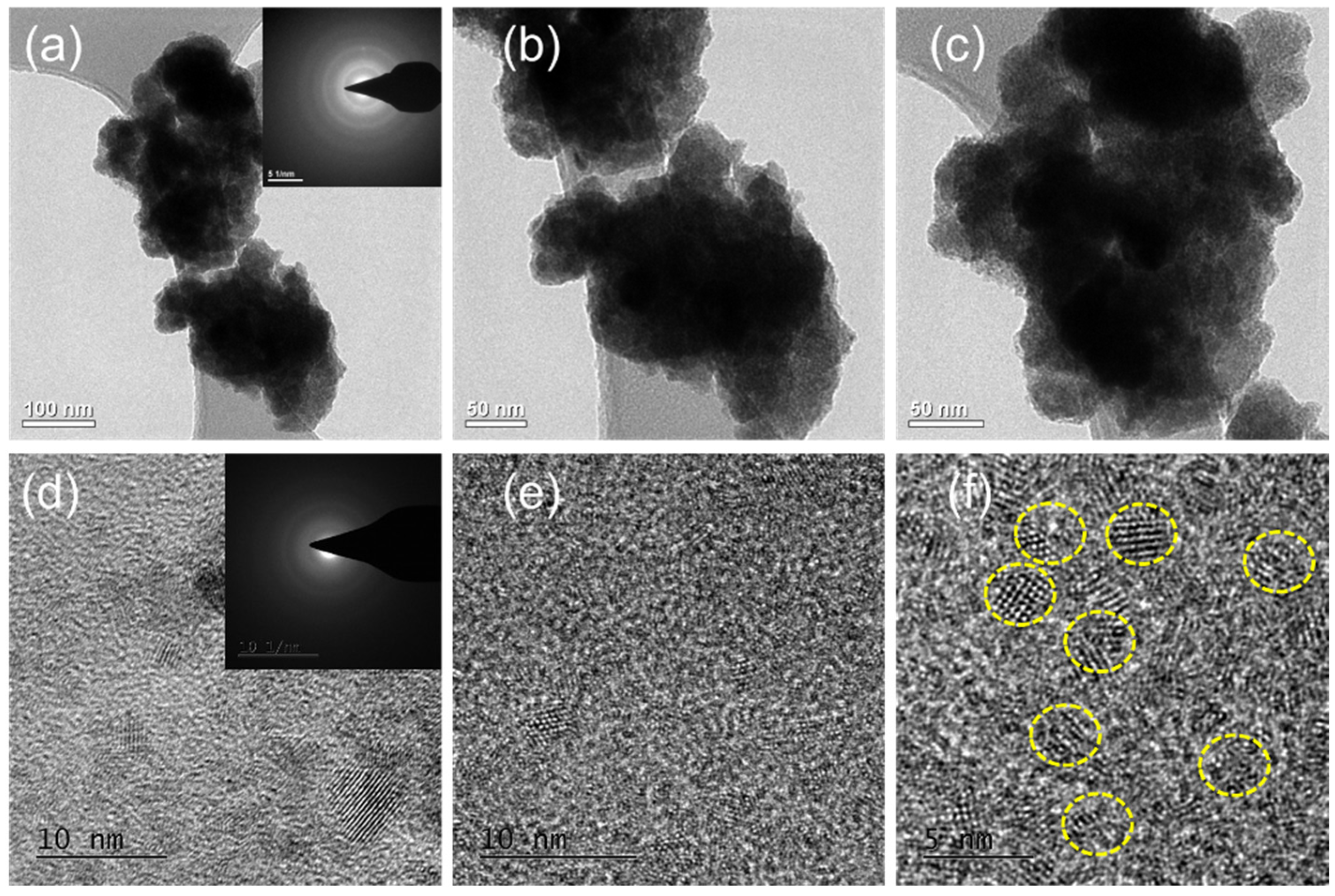



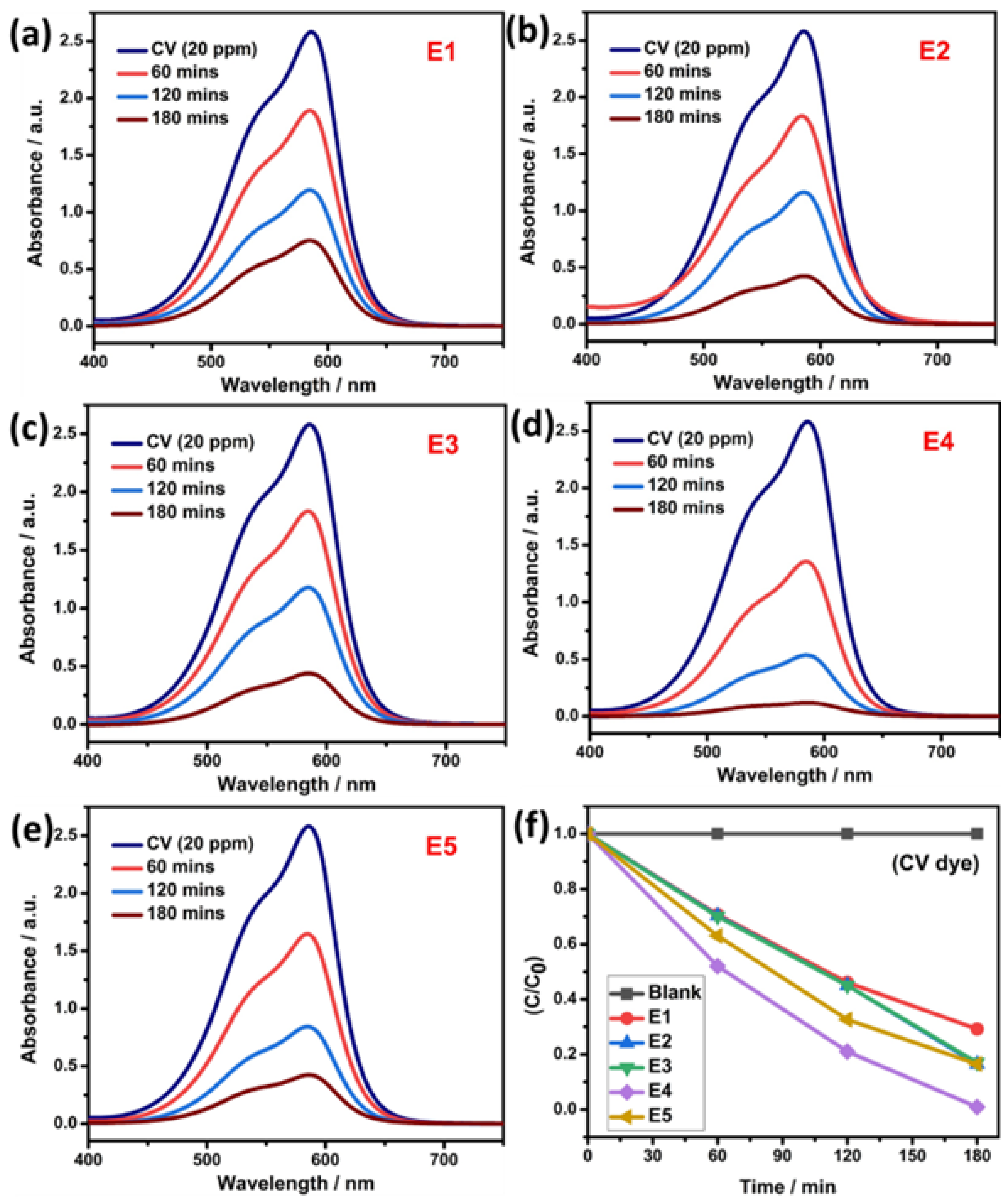
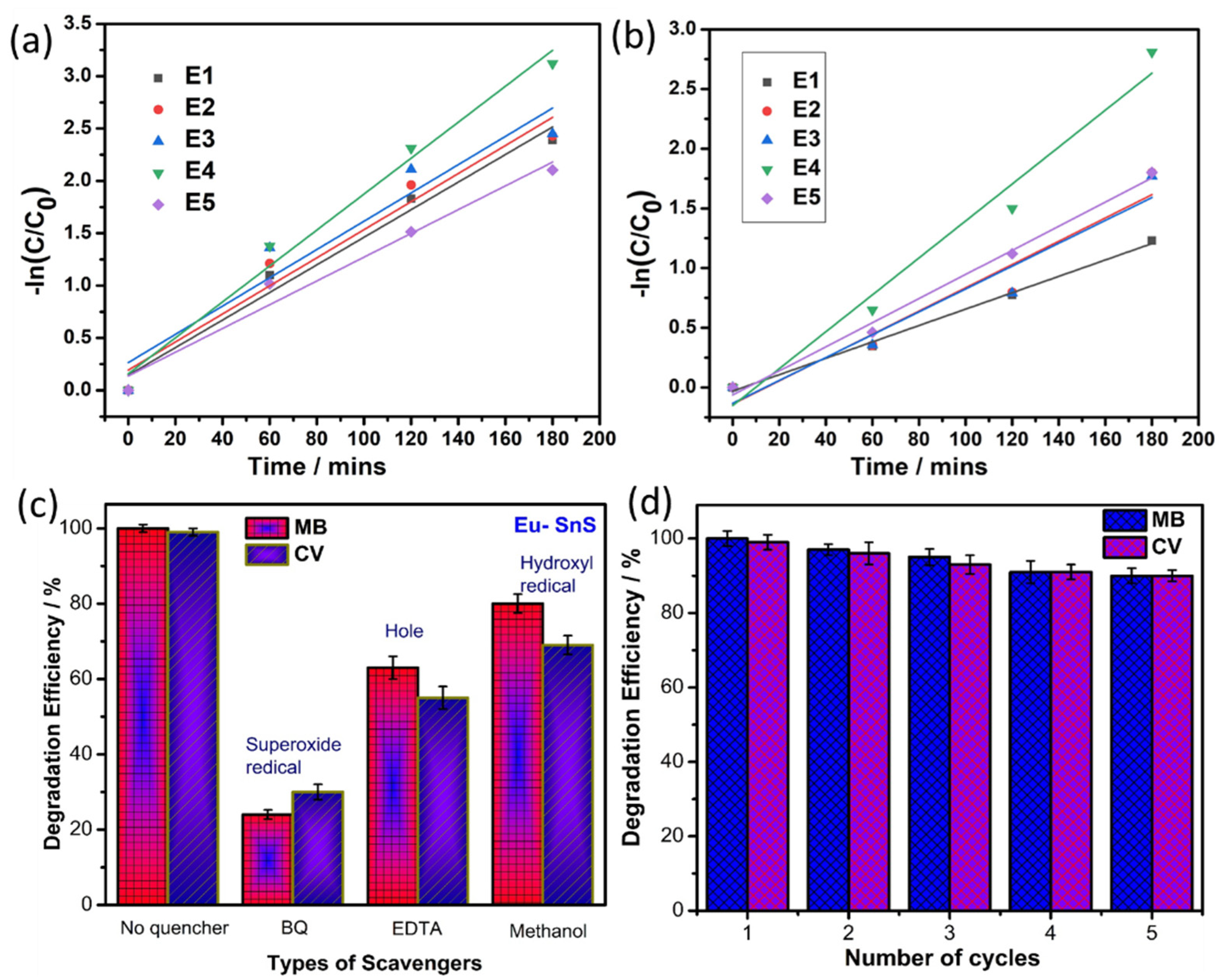
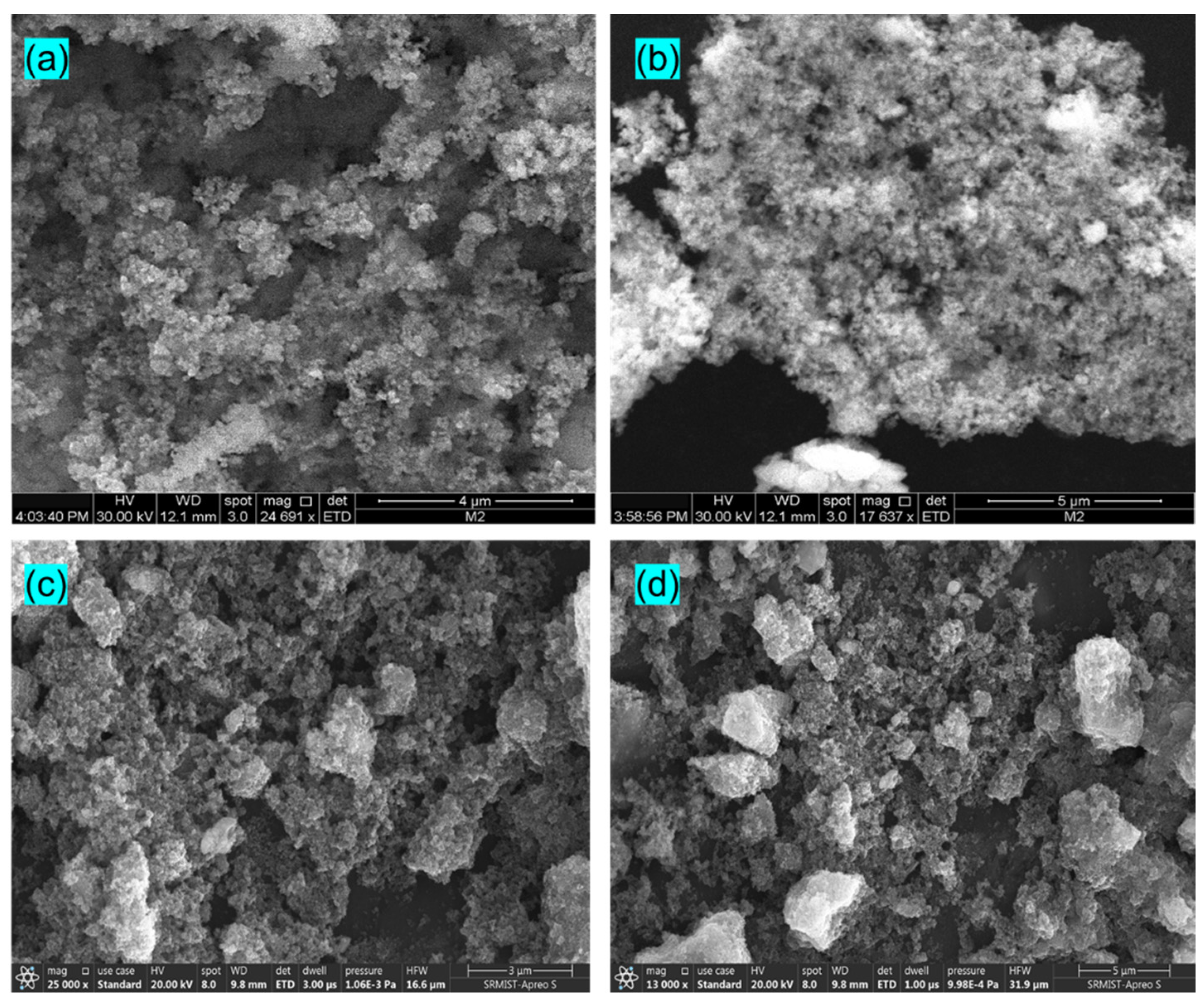
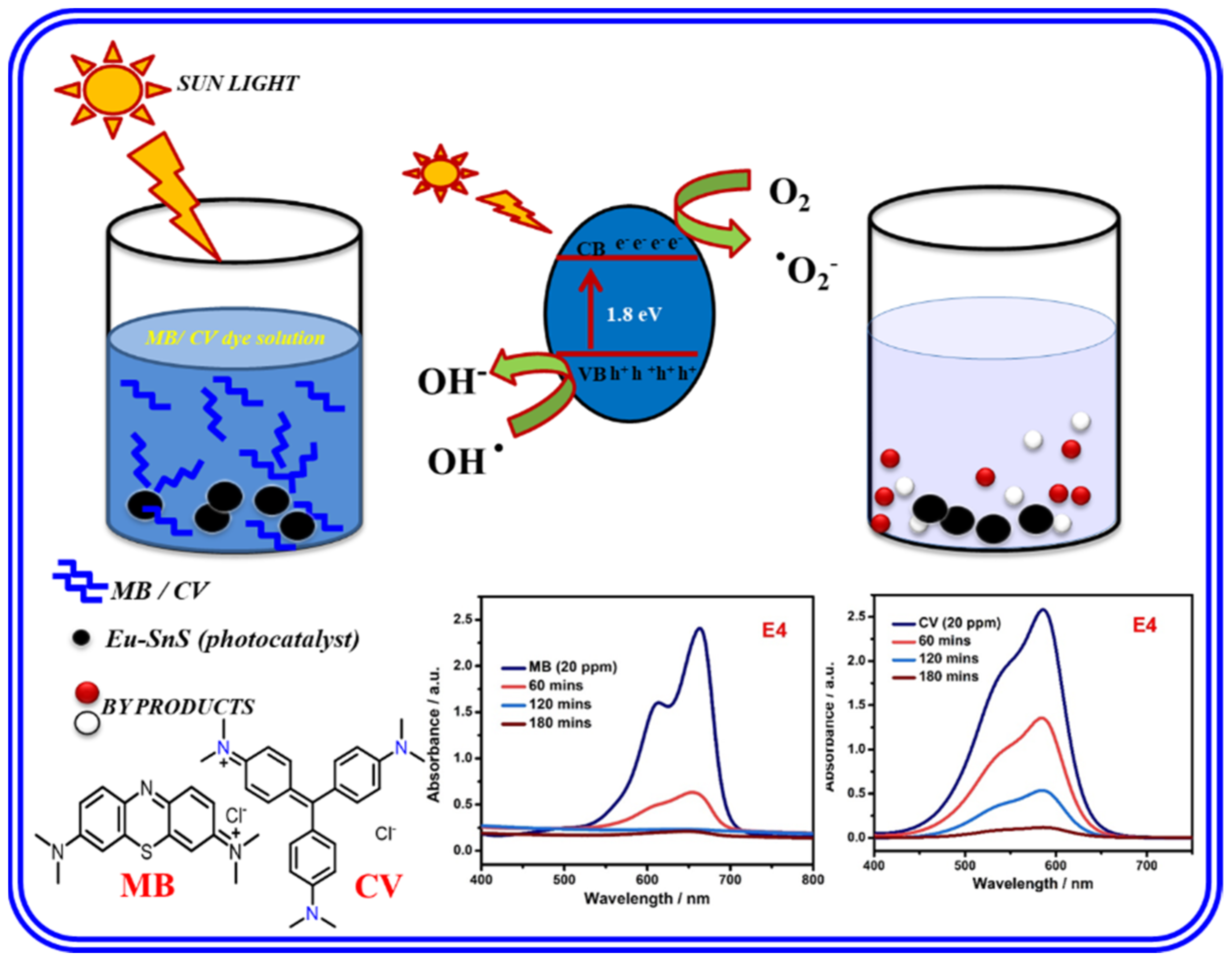
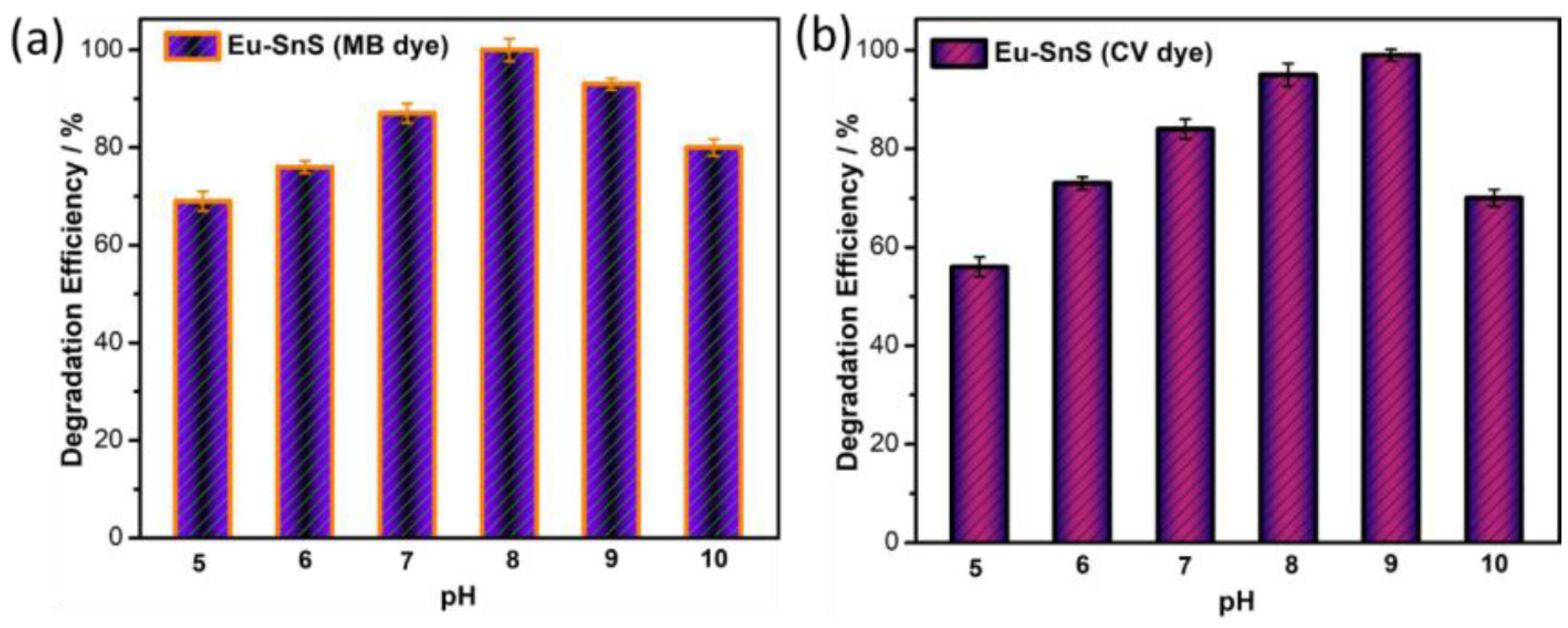
| S. No. | Catalyst | Band Gap (eV) | K (min−1) | R2 |
|---|---|---|---|---|
| MB dye solution (20 ppm) | ||||
| 1 | E1 | 3.12 | 0.030 | 0.964 |
| 2 | E2 | 3.03 | 0.030 | 0.938 |
| 3 | E3 | 2.89 | 0.031 | 0.889 |
| 4 | E4 | 2.81 | 0.039 | 0.975 |
| 5 | E5 | 2.72 | 0.025 | 0.959 |
| CV dye solution (20 ppm) | ||||
| 6 | E1 | 3.12 | 0.015 | 0.994 |
| 7 | E2 | 3.03 | 0.022 | 0.904 |
| 8 | E3 | 2.89 | 0.022 | 0.907 |
| 9 | E4 | 2.81 | 0.035 | 0.961 |
| 10 | E5 | 2.72 | 0.232 | 0.989 |
Publisher’s Note: MDPI stays neutral with regard to jurisdictional claims in published maps and institutional affiliations. |
© 2022 by the authors. Licensee MDPI, Basel, Switzerland. This article is an open access article distributed under the terms and conditions of the Creative Commons Attribution (CC BY) license (https://creativecommons.org/licenses/by/4.0/).
Share and Cite
Murugadoss, G.; Prakash, J.; Rajesh Kumar, M.; Alothman, A.A.; Habila, M.A.; Peera, S.G. Controlled Synthesis of Europium-Doped SnS Quantum Dots for Ultra-Fast Degradation of Selective Industrial Dyes. Catalysts 2022, 12, 1128. https://doi.org/10.3390/catal12101128
Murugadoss G, Prakash J, Rajesh Kumar M, Alothman AA, Habila MA, Peera SG. Controlled Synthesis of Europium-Doped SnS Quantum Dots for Ultra-Fast Degradation of Selective Industrial Dyes. Catalysts. 2022; 12(10):1128. https://doi.org/10.3390/catal12101128
Chicago/Turabian StyleMurugadoss, Govindhasamy, Jayavel Prakash, Manavalan Rajesh Kumar, Asma A. Alothman, Mohamed A. Habila, and Shaik Gouse Peera. 2022. "Controlled Synthesis of Europium-Doped SnS Quantum Dots for Ultra-Fast Degradation of Selective Industrial Dyes" Catalysts 12, no. 10: 1128. https://doi.org/10.3390/catal12101128
APA StyleMurugadoss, G., Prakash, J., Rajesh Kumar, M., Alothman, A. A., Habila, M. A., & Peera, S. G. (2022). Controlled Synthesis of Europium-Doped SnS Quantum Dots for Ultra-Fast Degradation of Selective Industrial Dyes. Catalysts, 12(10), 1128. https://doi.org/10.3390/catal12101128










